エッセイ エッセイ一覧
[エッセイ10:ひょんなことからNo.4]Tales from Yogascapes in Japan(Patrick McCartney)
2019年02月08日
[A sudden twist of fate 04]
Tales from Yogascapes in Japan
Patrick McCartney
Part-Time Research Fellow, Anthropological Institute
 |
| (https://www.yogascapesinjapan.com/) |
Yogascapes in Japan is a Japan Society for Promotion of Science (JSPS) funded research project hosted by the Graduate School of Global Environmental Studies at Kyoto University. The aim of this project is to contextualise global yoga within the Japanese cultural setting. The intention is to compare what we learn about yoga in Japan with what we know about yoga from other parts of the world. It is hoped that this will create greater nuance toward understanding the richer tapestry of one of globalisation's true success stories. One of the main reasons for this aim is due to the fact that much of what is written about modern yoga studies privileges a western-centric, global north context. In part, the intention of this project has been to pivot the academic gaze into a previously under appreciated corner of Yogaland; which is the emic term used by many people to either affectionately or pejoratively refer to this imaginary -scape that defines the participatory boundaries of yoga's consumption. It is so ubiquitous, one can find it used as a tag on Instagram, #yogaland.
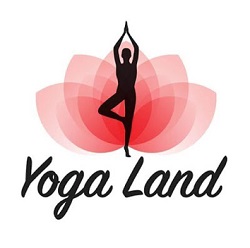 |
| (https://www.instagram.com/explore/tags/yogaland/?hl=en) |
What is meant by 'global yoga' is the transnational popularity of a variety of yoga-inspired lifestyles; which relates to global flows of capital, as well as the transcultural flows of ideas. While modern yoga has historical roots in South Asia, it is a syncretic, hybrid form of not only spirituality, but also exercise; which is linked to the political struggle for Indian independence. Postural yoga evolved alongside body building culture to create antithetical masculine bodies that could counter the effeminate orientalist/colonialist narrative. Over a century later, it is fascinating that the overwhelming majority of consumers of yoga are women. And, interestingly, while the average gender split around the world is approximately 80-85 percent women; in Japan, the figure is considerably higher. My own observations and testimonies of industry leaders is that the average is about 95-99 percent women. Some yoga teachers have told me that their client base is 100 percent women. Yoga, is undeniably a gendered space. So much so, that, this example is quite revealing of the anxiety one might perceive related to gendered nature of yoga. On occasion, a man approached me after a yoga class I attended in Osaka, and said, "Hi, my name Hiroto. I am not gay. I just really like yoga."
The gender split is one example of the main focal points of this research; which seeks to document how the consumption of yoga might be different, or similar, in Japan, compared to yoga in other countries. A lot of what we know about the multibillion-dollar global yoga industry is from observations made outside of Asia (not including South Asia, although, at least in the public spaces of Pakistan, it is 100 percent who are performing yoga, ostensibly as sport and a way to connect to their shared ancient past through the Indus Valley Culture; which is controversially linked by Hindu nationalists to a cultural continuity between the IVC and the Hindu precursor, i.e. the Vedic culture) and the global south. Therefore, there is an under-developed sense of what 'global yoga' truly encompasses; which this project seeks to make a humble contribution towards. It is also what the next stage of this project seeks to challenge, which is our preconceived notions of what yoga is and how it is used by various state and non-state actors, particularly in the global south. There is a distinct rhetoric that yoga is an instrument that can improve not only individual and global wellbeing, but also lead to social transformation. Here is an article from scholars at the University of Tsukuba. In which they state, that:
 |
| (https://juniperpublishers.com/jyp/pdf/JYP.MS.ID.555684.pdf) |
"In recent years in Japan too, the Yoga population is rapidly increasing. However, little attention has been paid to the true value and possibilities of Yoga. The real value and possibilities of Yoga lies in becoming a person who can live with the aim of self-transformation and social-transformation. Self transformation here means to look deeply at oneself, regain free self and enrich one's life. In our hearts, there is a heart of fierce desire, anger, envy, jealousy, grudge, and hatred."
This example, below, shows how a transformative narrative underpins the coercive logic of wellness, which yoga is indelibly conjoined with.
 |
In relation to boundaries, and the politics of representation, one principal question guiding this project is: In which discursive contexts do we find yoga, transformative (self-)development, and global citizenship combine? This idea of transformation at a societal level is essentially what my next project focuses on. For more information about that, this link provides an overview.
As this project has evolved, the focus on exploring various chains of signifiers has come into greater focus. One, in particular relates to the confluence of ideals linked to combining yoga + zen + temples under the context of 寺ヨガ 'temple yoga' or お寺のヨガ. The creation of demand for this popular, neo-romantic, orientalist-inspired consumption considers that the ultimate zen experience occurs through combining zen with yoga. One example is found in the heart of busy Tokyo at the 五百羅漢寺 Tenonzan Gohyaku Rakan-ji temple in Meguro. We are told that, "If you're tired of gym yoga sessions, dangerously candle-lit home yoga or YouTube-inspired practices, here is a new option for you: Temple Yoga in the very heart of Tokyo."
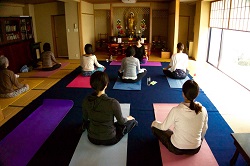 |
| (https://savvytokyo.com/temple-yoga-ultimate-zen-experience/) |
Actually, the first temple I visited in Kyoto, Myōman-ji Temple 妙満寺, displayed a sign, printed in bold, black ink on A4 paper, affixed next to office door, which simply said, 'YOGA'. While this class does not appear to be running anymore, the teacher explained that she taught 'Chakra yoga,' 'Kriya yoga,' and 'Hatha yoga.' These denominations are, in many ways, irrelevant. This is because they are more or less describing similar practices. For instance, in order to practice the more esoteric Kriya yoga, one must also work with chakras. In reality, the classes were essentially the Shivananda style of yoga, named after Swami Shivananda (1854-1934). His style of yoga is certainly more popular than what I anticipated it would be in Japan. In fact, it would seem that the most popular style, or rather, genre of yoga, is what we can understand as ゆつたり yuttari ヨガ yoga, or 'relaxed yoga.' Even though one industry report shows that many people consider Pilates to be the most popular style of yoga. This exposes an interesting cultural and linguistic disconnect. Since it is well known that Pilates is a distinctly separate bodily regime than yoga. Regardless of how similar they appear to be. This, perhaps, tells us something about the market research, or perhaps even the people interviewed, as well. And how they come to understand imported cultural products.
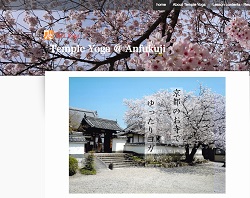 |
The classes ran mid-morning on Monday, Wednesday, and Friday. They were held in a large, upstairs room in the newer building of the temple complex, which had approximately 120 tatami mats. The customers of this class were all women aged between 40-70 years of age.
This form of temple yoga tourism is particularly prevalent in Kyoto; which is famous for its temples and history. Here is one example; which resulted in a yoga teacher from South India facilitating a multi-day retreat that took place in the Daishin-in temple, which is part of the 妙心寺 Myōshin-in complex in western Kyoto. Interestingly, the organiser of this event, a Japanese woman who lives in Australia, explained how they had found little interest amongst the local yoga scene for people to attend this 9-day event. Instead, most of the people present on the day we attended were international disciples of the teacher who had come from as far as Denmark, Hong Kong, Australia, and Korea. This is a very common occurrence. For many yoga teachers, it is more the case of organising events for one's students to attend, rather than trying to get new customers to invest. The cost, alone, is prohibitive. A 9-day event like this one will easily cost USD 4000, once all the costs are accounted for. And this is certainly not a high-end retreat.
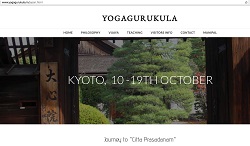 |
While many might lament the hyper-commodification of 'traditional' or 'authentic' practices, these terms have, for better or worse, high semantic valency; which means they are able to assign meanings that go beyond the original intentions. Not only in Japan, there are many examples of yoga + zen combined across the world, ostensibly to create demand, cultivate affect, and inspire consumption. Here is one event that occurs a few times a year in famous tea growing area of Wazuka. It combines a yoga class, a short jog across town, and a meditation session in a temple; followed by tea and sweets, and the chance to talk to the priest and each other. This is a good example of the syncretic nature and secondary wellness preference that combines several activities into one program, instead of a primary wellness event that is singular in focus. Of which the overwhelming majority of wellness tourists (85 percent) prefer secondary wellness options that offer a diversity of pursuits.
(写真)
And, while these examples above adopt various appeals to purity and tradition, this heterogenously-unregulated market enables a plurality of dispositions and yoga-inspired options. One example is SUP Yoga. Stand-Up Paddleboard Yoga. This particular example comes from Biwako, Shiga.
 |
 |
 |
| (https://www.biwako-sup-yoga.com/) |
According to one Japanese yoga industry report from 2017. The industry is valued at ¥260 Billion. This equals AUD3 Billion or USD2.3 Billion. Currently, there are approximately 5.9 million yoga practitioners in Japan. However, this is expected to grow to 16 million over the next coming years.
Coming back to the temple yoga, briefly, it is worth putting this into perspective. The Japanese government wants to double foreign tourist arrivals from the current 28 million per annum to 60 million by 2030. The aim is entice tourists to travel outside of Tokyo, Nara, Osaka and Kyoto so that rural areas can also enjoy some of the economic benefits of the current tourist boom. One way of doing this is through temple yoga + homestay options. Such as this option, below.
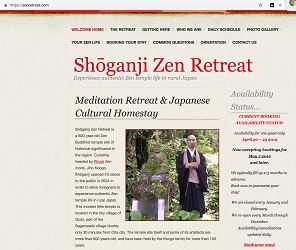 |
| (https://zenretreat.com/) |
This graph shows just how much of a boom Japan is currently experiencing.
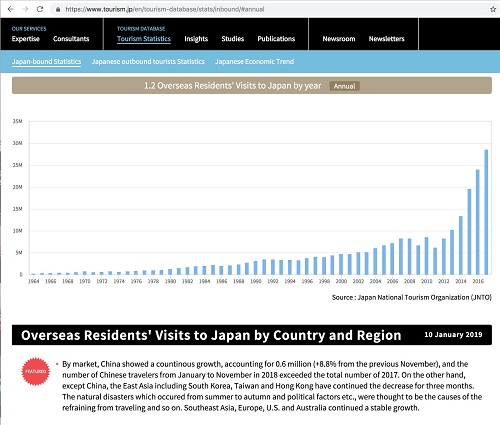 |
| (https://www.tourism.jp/en/tourism-database/stats/inbound/#annual) |
Still, one thing that is currently unclear is how much economic input is derived from people wanting to spend their holidays in temples and doing some or a lot of yoga. Quantifying this proves more elusive than anticipated. Perhaps, people are more inclined to experience a Zensation? Rather, than spend time sitting quietly.
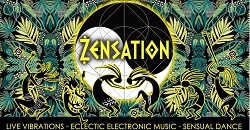 |
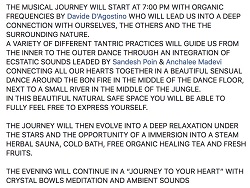 |
|
(https://www.facebook.com/events/1425367957598707/?event_time_id=1425368007598702) |
|
It is quite difficult to say in only two short years all that there is to know about yoga in Japan. Still, with more time, it is anticipated that a greater understanding of the many forms of yoga can be highlighted, and, also, the people interested in them.